If you’re looking to create the perfect environment for your purple Betta fish, you’ve come to the right place. Betta fish, also known as Siamese fighting fish, are popular for their vibrant colors, unique personalities, and relatively low maintenance.
In this comprehensive guide, we will explore everything you need to know about Betta fish care, from tank setup to their dietary needs and the natural habitat they thrive in. By following these tips and guidelines, you can ensure your purple betta fish remains happy and healthy.
Understanding the Purple Betta Fish
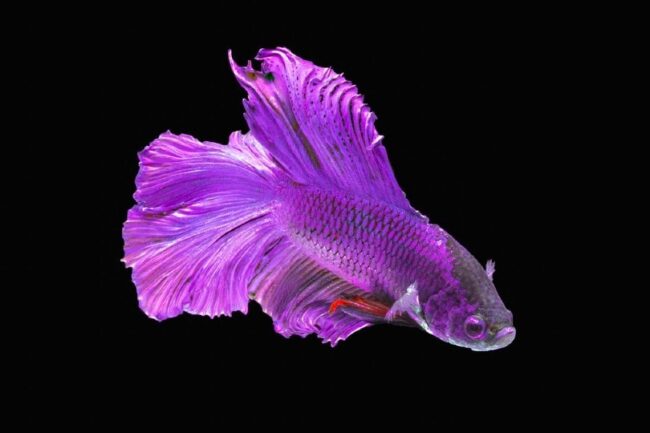
Before we dive into the specifics of tank setup and care, let’s first understand what makes the purple Betta fish unique. Known for their striking coloration, purple Bettas are highly sought after by fish enthusiasts. Their vibrant shades of purple, often mixed with other colors like blue or red, make them a captivating addition to any aquarium.
Betta Fish Origins
Betta fish are native to the shallow waters of Southeast Asia, particularly Thailand, Cambodia, Laos, and Vietnam. These regions have warm, slow-moving waters with abundant vegetation, which serve as a crucial reference point for creating the perfect tank environment.
Betta Fish Behavior
Purple Bettas are known for their territorial behavior, and it’s important to be aware of this when planning their tank setup. They are called “fighting fish” for a reason – male Betta fish can be aggressive towards other males, especially if they share a small space. This is why it’s crucial to provide them with the right tank conditions.
Tank Setup for Purple Betta Fish
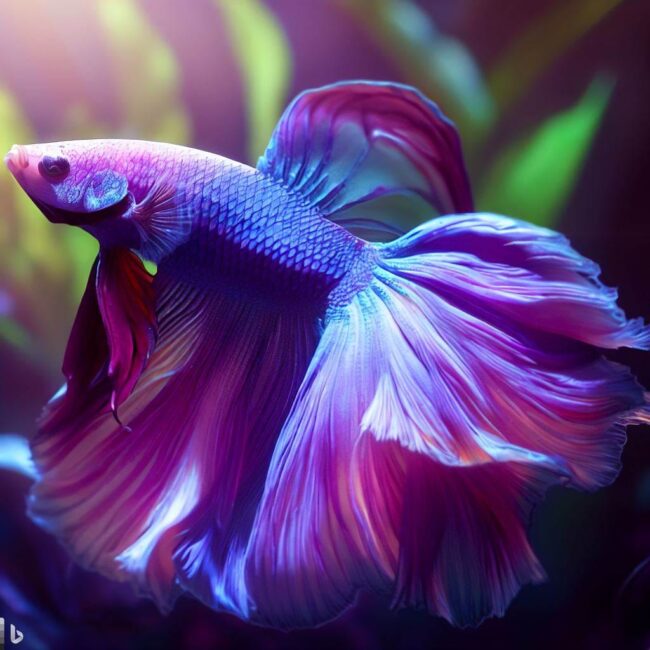
The first step in Betta fish care is setting up their home. Here’s a detailed guide to creating the ideal tank environment for your purple Betta:
Tank Size
One of the most common misconceptions is that Betta fish can thrive in tiny bowls. In reality, Betta fish need ample space to swim and explore. A tank with a capacity of at least 5 gallons is recommended to ensure their well-being.
Water Parameters
Maintaining the right water parameters is crucial for Betta fish. They prefer warm water with a temperature range of 78-80°F (25-27°C). Use a reliable aquarium heater to maintain the desired temperature.
The water should be kept clean and well-filtered to prevent the buildup of harmful substances. Regular water changes (about 25% of the tank volume every two weeks) are essential to ensure a healthy environment.
Decoration and Substrate
Betta fish love to have places to hide, so include live or silk plants and caves in the tank. Soft silk plants can prevent any damage to their delicate fins. Betta fish may become stressed in a bare environment, so providing some decorations is beneficial.
When it comes to substrate, fine gravel or sand is a suitable choice. Make sure it’s clean and free from any sharp edges that could harm your Betta.
Feeding Your Purple Betta Fish
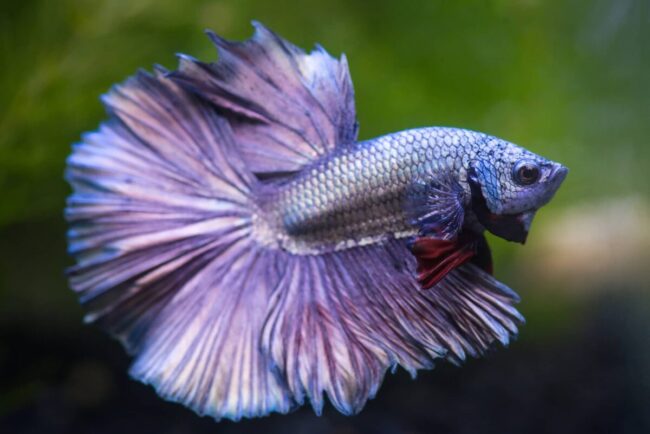
A well-balanced diet is crucial for the health of your Betta fish. These fish are carnivorous and require a diet rich in protein. Here are some important aspects to consider when feeding your purple Betta:
Pellets vs. Live Food
Betta fish readily accept high-quality Betta pellets. These pellets are formulated to provide the essential nutrients and color-enhancing ingredients your Betta needs. Alternatively, you can occasionally supplement their diet with live or frozen food like bloodworms or brine shrimp.
Feeding Schedule
Feed your Betta small amounts two to three times a day. It’s important not to overfeed, as this can lead to obesity and health issues. The key is to maintain a balanced diet.
Quality Matters
Always opt for high-quality Betta pellets or live foods. Low-quality foods may lack the essential nutrients that your Betta requires to maintain its vibrant color and overall health.
Emulating the Natural Habitat
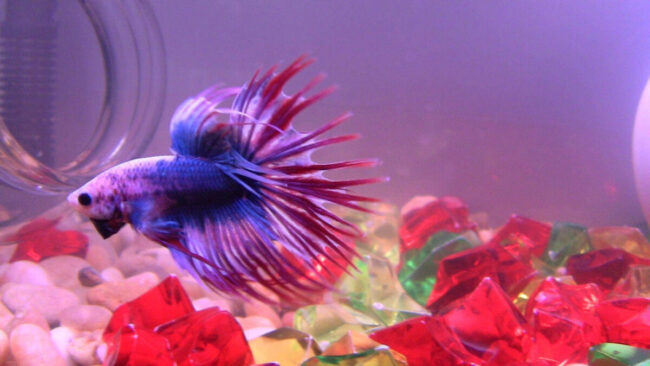
Creating an environment that mimics their natural habitat is essential for the well-being of your purple Betta fish. While it’s not always possible to replicate their native waters precisely, you can make an effort to include certain elements in their tank:
Plants
Adding live or silk plants to the tank not only provides hiding spots but also helps improve water quality by absorbing excess nutrients and producing oxygen.
Gentle Water Movement
Betta fish come from slow-moving waters, so avoid strong water currents. Gentle filtration and the use of a sponge filter can help maintain the ideal conditions.
Betta Community
If you plan to have multiple Betta fish in the same tank, ensure there are enough hiding spots and that you have a much larger tank to reduce territorial disputes.
Conclusion
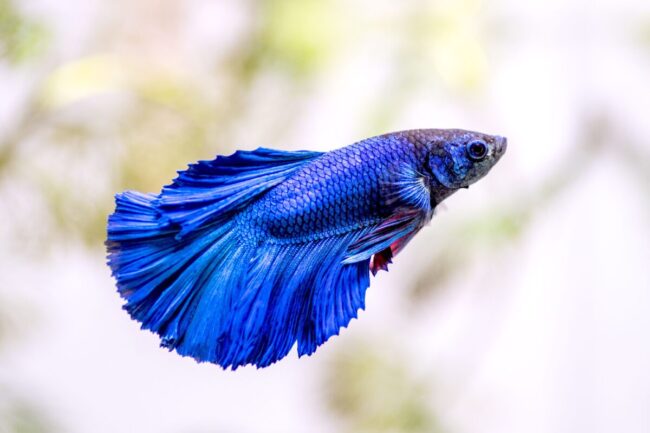
In summary, providing proper care for your purple Betta fish involves creating an ideal tank environment, offering a well-balanced diet, and emulating their natural habitat. By following these guidelines, you can ensure that your Betta remains healthy and thrives in captivity. Remember, a happy Betta is a beautiful Betta, and with the right care, your purple Betta fish can truly stand out as a gem in your aquarium.
Now that you have a comprehensive understanding of how to care for your purple Betta fish, it’s time to put this knowledge into practice. By following these recommendations, you can provide the best possible care for your Betta and watch it flourish in its new home.
Frequently Asked Questions
What size tank is best for beginners?
A 20 to 30-gallon tank is a good starting point for beginners. It’s large enough to maintain stable water conditions but not overly complicated.
How often should I change the water in my tank?
Regular water changes should be done every 1-2 weeks, typically changing 10-20% of the water volume.
Should I offer different foods to my fish?
Variety is good for most fish. Offering a mix of flakes, pellets, and occasional live or frozen foods can help provide a balanced diet.
Can I keep different species of fish together in the same tank?
It’s possible, but compatibility varies. Research the temperament and habitat requirements of each species to ensure they can coexist peacefully.
How do I know if my fish are stressed or sick?
Signs of stress or illness can include changes in behavior, loss of appetite, color changes, fin clamping, or visible physical abnormalities. Regular observation is crucial.
